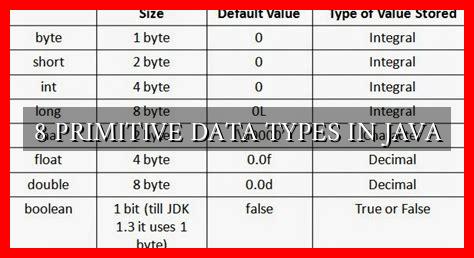-
Table of Contents
8 Primitive Data Types in Java
When programming in Java, understanding the different data types available is crucial for writing efficient and effective code. Java has eight primitive data types that are used to store simple values. In this article, we will explore each of these data types in detail, along with examples to illustrate their usage.
1. byte
The byte data type is an 8-bit signed two’s complement integer. It has a minimum value of -128 and a maximum value of 127. This data type is commonly used when working with small numbers or when memory conservation is a priority.
- Example:
byte num = 10;
2. short
The short data type is a 16-bit signed two’s complement integer. It has a minimum value of -32,768 and a maximum value of 32,767. Short is typically used when a small range of values is needed.
- Example:
short num = 1000;
3. int
The int data type is a 32-bit signed two’s complement integer. It has a minimum value of -2,147,483,648 and a maximum value of 2,147,483,647. Int is the most commonly used data type for integer values in Java.
- Example:
int num = 10000;
4. long
The long data type is a 64-bit signed two’s complement integer. It has a minimum value of -9,223,372,036,854,775,808 and a maximum value of 9,223,372,036,854,775,807. Long is used when dealing with large integer values that exceed the range of int.
- Example:
long num = 1000000000L;
5. float
The float data type is a single-precision 32-bit IEEE 754 floating point. It can represent fractional numbers and has a wider range than int or long. Float is used when dealing with decimal values that do not require high precision.
- Example:
float num = 3.14f;
6. double
The double data type is a double-precision 64-bit IEEE 754 floating point. It is the default choice for decimal values in Java due to its higher precision compared to float.
- Example:
double num = 3.14159;
7. char
The char data type is a single 16-bit Unicode character. It can store any character, including letters, digits, and special symbols.
- Example:
char letter = 'A';
8. boolean
The boolean data type represents a boolean value, which can be either true or false. Booleans are commonly used for conditional statements and logical operations.
- Example:
boolean flag = true;
Summary
In conclusion, Java offers a variety of primitive data types to suit different programming needs. By understanding the characteristics and usage of each data type, developers can write more efficient and reliable code. Whether working with integers, floating-point numbers, characters, or boolean values, Java provides the tools necessary to handle a wide range of data types.
For more information on Java data types, you can refer to the official Oracle documentation.





